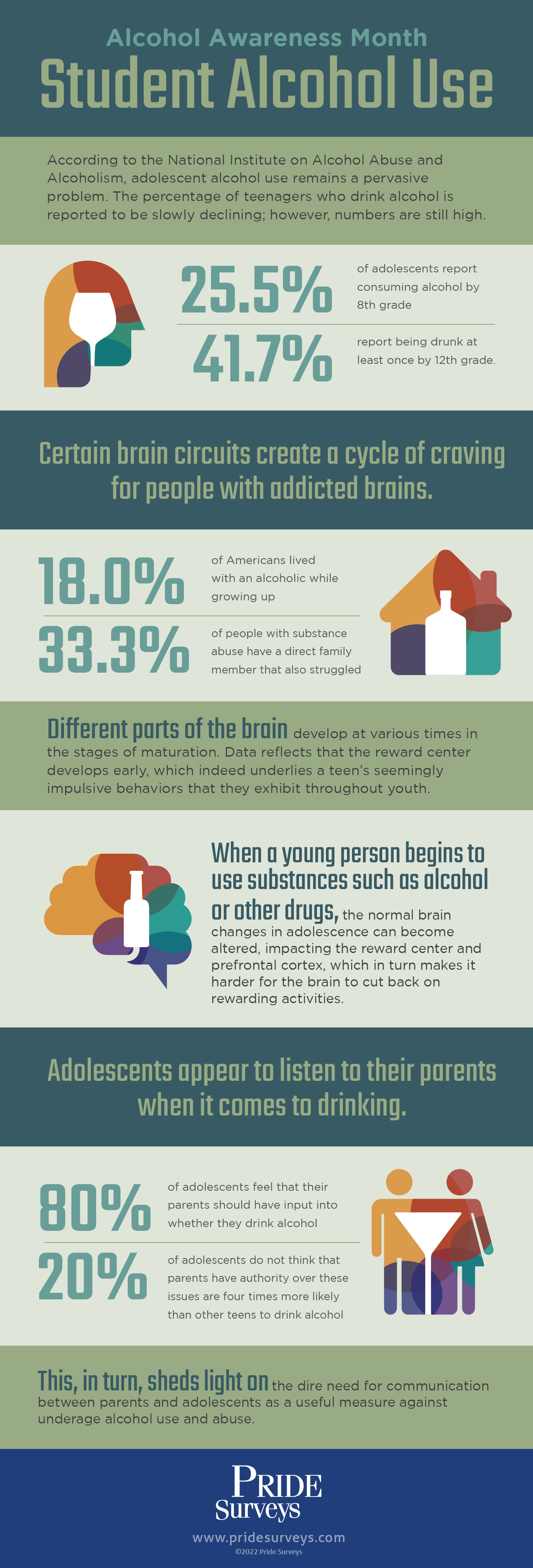Sign up for our information-filled email newsletter

Student Alcohol Use: April is Alcohol Awareness Month

Every April, the National Council for Alcoholism and Drug Dependence (NCADD) sponsors Alcohol Awareness Month to increase understanding and awareness of alcoholism, a rising epidemic in the United States. Here at Pride Surveys, we are actively committed to working with our partners in education and community coalitions to provide data, research, and resources surrounding student alcohol use and the substance abuse epidemic amongst youth. When national awareness months like this come around, we can give concise information on rising trends, symptoms, and behaviors.
For many in the United States, alcohol use is ingrained in the culture and entertainment as well as the social lives of some youth. According to the National Institute on Alcohol Abuse and Alcoholism, student alcohol use remains a pervasive problem. The percentage of teenagers who drink alcohol is reported to be slowly declining; however, numbers are still high. About 25.6 percent of adolescents report consuming alcohol by 8th grade, and about 41.7 percent report being drunk at least once by 12th grade.
But, what causes casual use for youth to become an addiction?

Pride Surveys | Student Alcohol Use – Alcohol Awareness Month
Research shows that certain brain circuits create a cycle of craving for people with addicted brains. People with trauma in their childhoods or a family history of addiction are at greater risk by a substantial amount. It is reported that almost one in five Americans, close to 18%, lived with an alcoholic while growing up and that one-third of people who struggle with substance abuse have a direct family member that also struggled. Seemingly just as important is the age at which someone is when they start to use alcohol. Research points to the fact that when someone starts earlier, the likelihood of becoming addicted later is higher due to the development patterns of the adolescent brain.
Most statistics suggest that developing brains are not at what are considered “adult levels” until their mid-twenties, with different parts of the brain developing at various times in the stages of maturation. Data reflects that the reward center develops early, which indeed underlies a teen’s seemingly impulsive behaviors that they exhibit throughout youth. Just think about what you did in your youth versus what you would do now. The prefrontal cortex then serves as the brakes on reward-driven impulse behaviors. But this part of the brain isn’t mature until the mid-twenties.
When a young person begins to use substances such as alcohol or other drugs, the normal brain changes in adolescence can become altered, impacting the reward center and prefrontal cortex, which in turn makes it harder for the brain to cut back on rewarding activities.
The good news is that adolescents appear to listen to their parents when it comes to drinking, especially if the messages are consistently given and with authority. Research suggests that the majority of adolescents, around 80 percent, feel that their parents should have input into whether they drink alcohol. Interestingly, those in the minority who do not think that parents have authority over these issues are four times more likely than other teens to drink alcohol and three times more likely to have plans to drink if they have not already started.
Research also points to that, regardless of unique parenting styles, youth who understand that their parents will be upset or more likely to punish them if they drank tend to be less likely to do so, at least in their underage years. This, in turn, sheds light on the dire need for communication between parents and adolescents as a useful measure against student alcohol use and abuse.
There are many resources and initiatives that have been developed throughout the years by other notable organizations that support communities and children by educating students and parents about the dangers and consequences of student alcohol use and abuse. One of the many reasons these organizations exist is due to support from companies such as Pride Surveys, which focuses on student data collection, trends, and shifts over time in the data covering substance abuse. Data collection is crucial in informing parents, students, educators, and community coalitions about substance use disorders and drug prevention.
If you notice signs of student alcohol use or alcohol abuse in someone you love, it is imperative to reach out to professionals. If your community coalition or school needs data to determine substance use and abuse issues that may be occurring, please get in touch with the Pride Surveys team. We offer a variety of substance abuse survey options to fit many needs.
Resources
Jackson, C. Perceived legitimacy of parental authority and tobacco and alcohol use during early adolescence. Journal of Adolescent Health 31(5):425–432, 2002.
Squeglia, L.M.; Jacobus, J.; and Tapert, S.F. The influence of substance use on adolescent brain development. Clinical EEG and Neuroscience 40(1):31–38, 2009.
Adolescent Substance Abuse: America’s #1 Health Problem, The National Center on Addiction and Substance Abuse at Columbia University, June 2011
America’s Dropout Crisis: The Unrecognized Connection to Adolescent Substance Abuse, DuPont et al., Institute for Behavior and Health, Inc., March 2013
https://www.thewoodsatparkside.com/why-is-alcohol-addictive-for-some-people-and-not-others/
https://americanaddictioncenters.org/alcoholism-treatment/symptoms-and-signs/hereditary-or-genetic

- The Spike In Teen Alcohol Abuse During Summer And How to Combat It
- Substance Use Prevention in Youth Heading Into Summer
- Substance Use Prevention and Resources
- The Impacts of ADHD on Youth Substance Abuse
- How the Mental Health Professional and Teacher Shortage Affects Students




